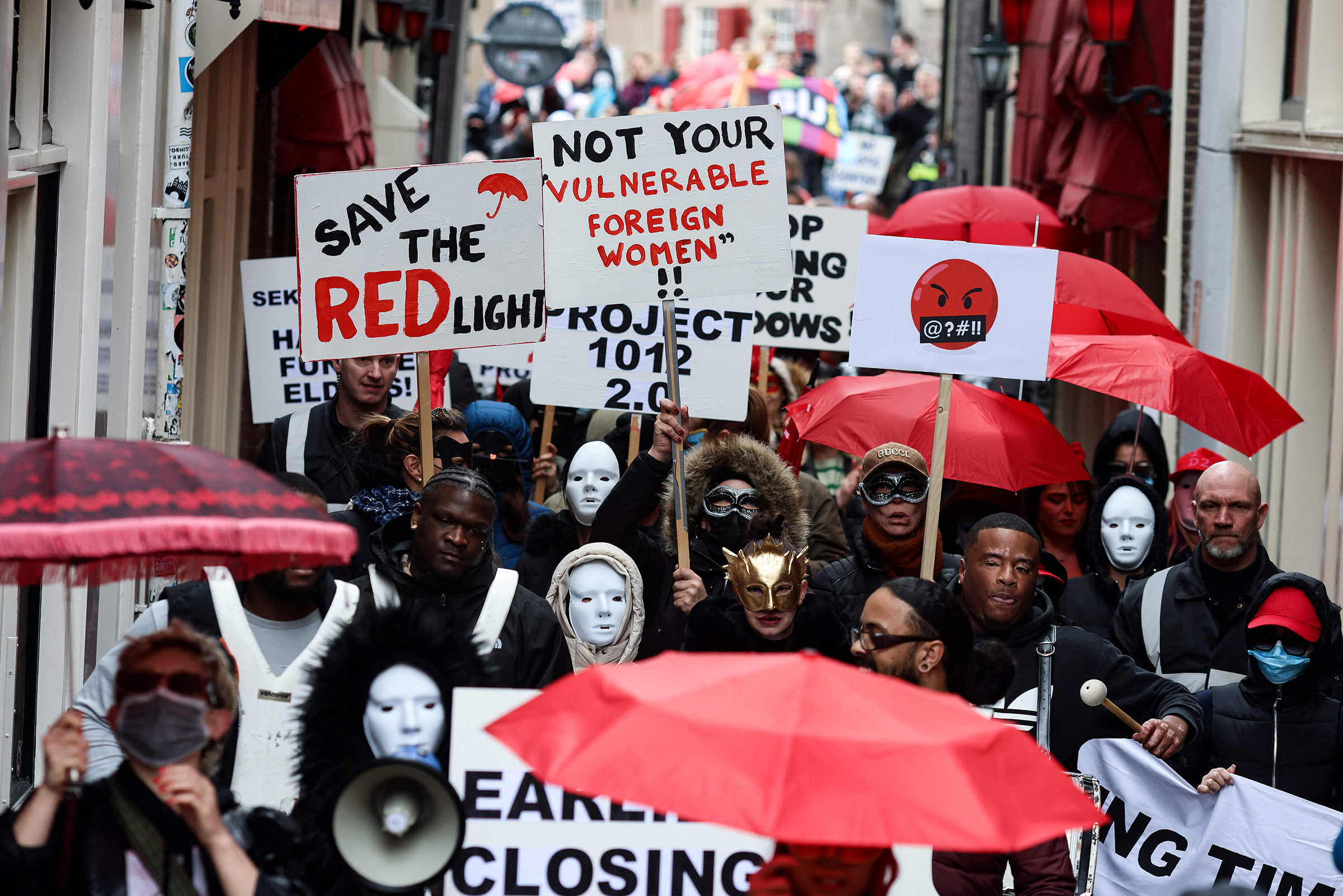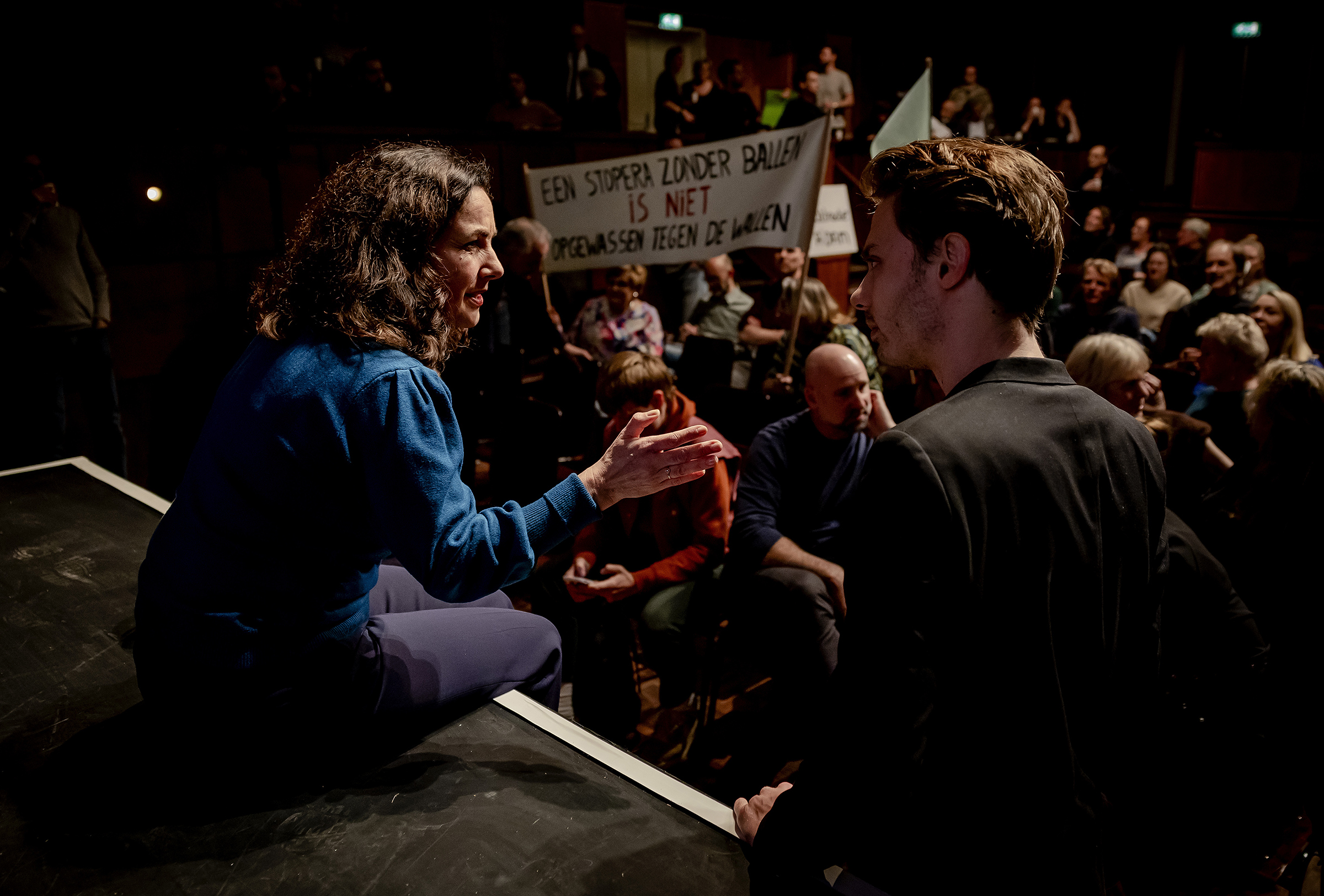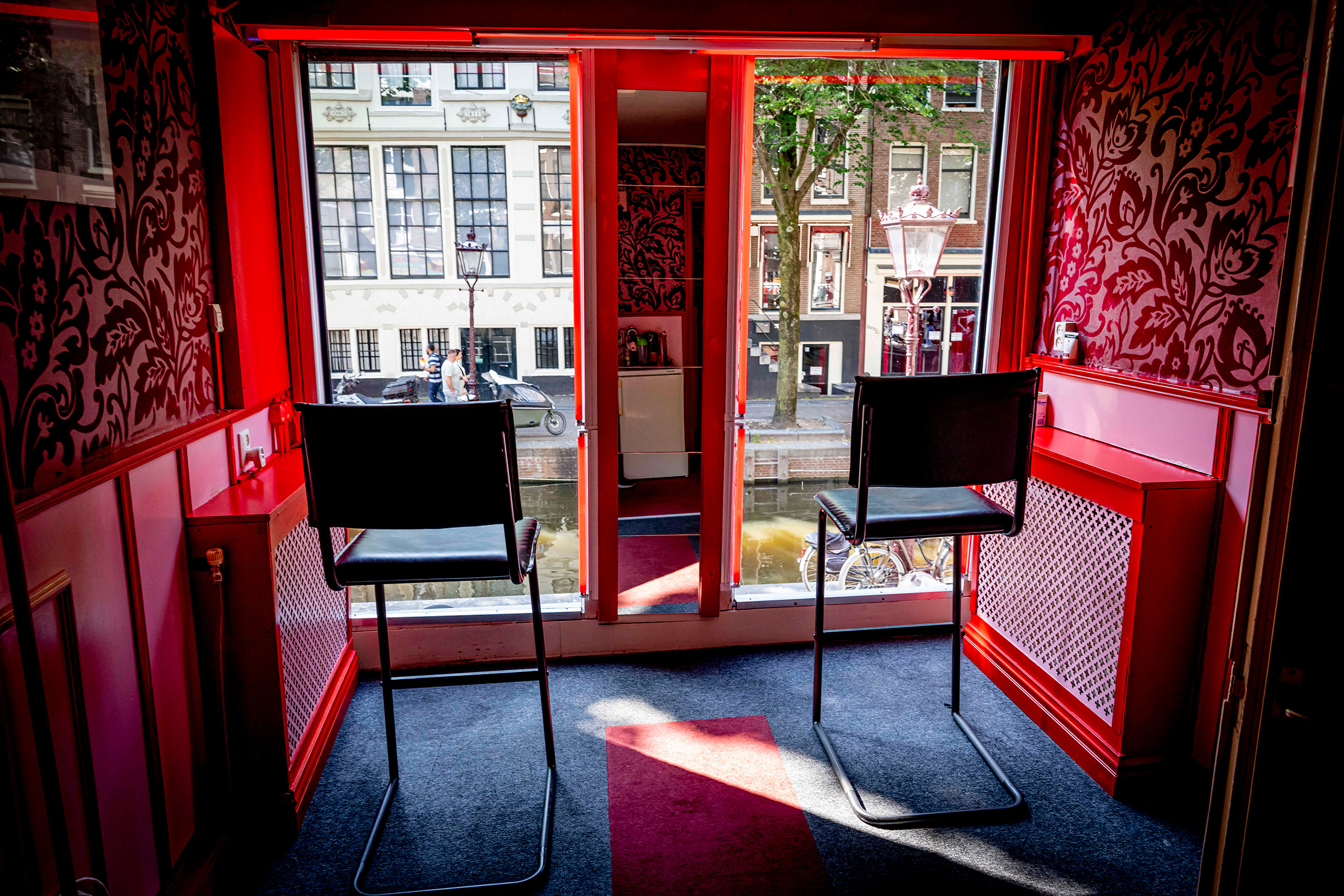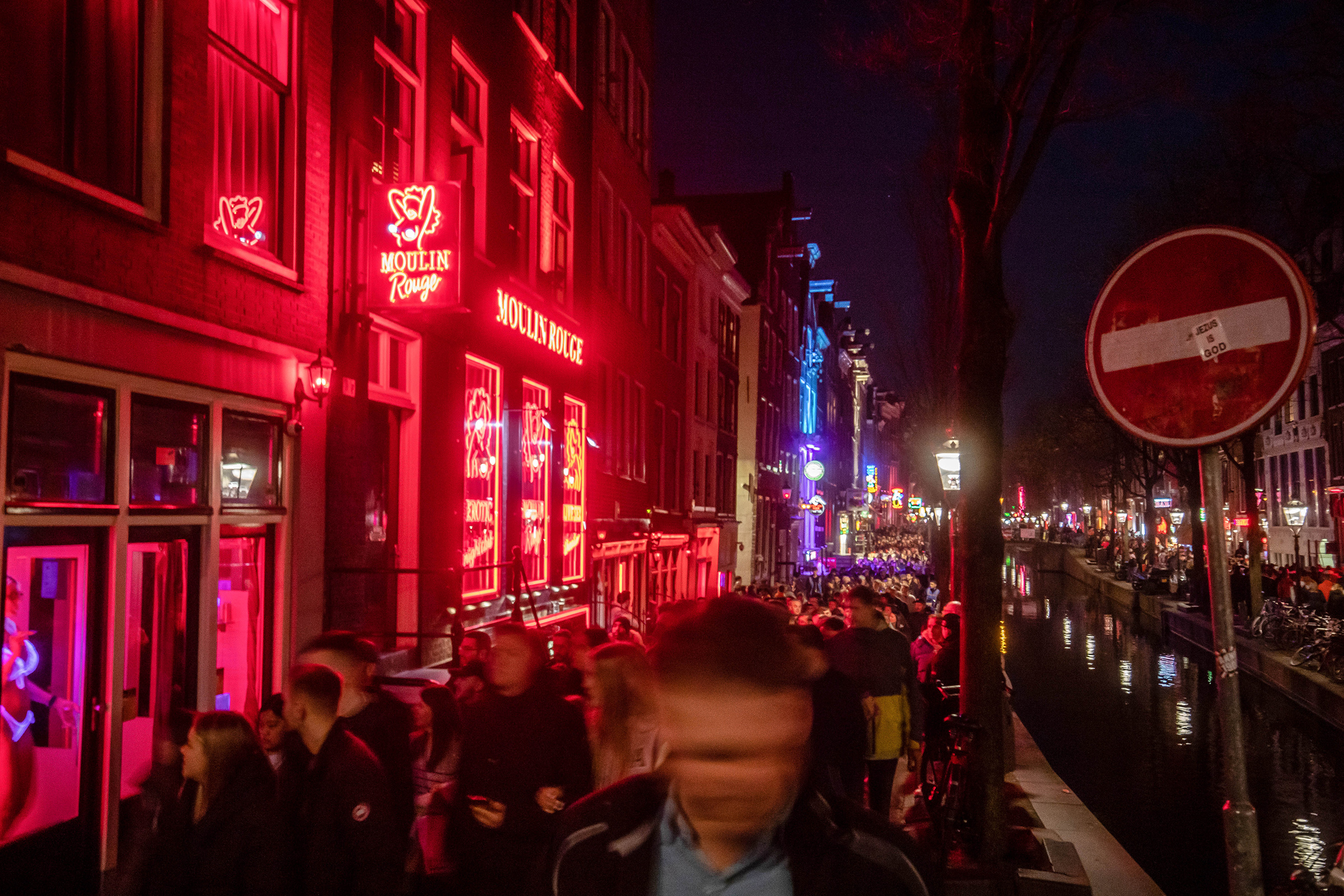It is 11 a.m. on a weekday in late June in Amsterdam’s De Wallen district, and a clean-up operation is underway. Street sweeping machines are collecting trash that hints at a raucous time the night before: cigarette packs, spliff butts, and empty cannabis baggies litter the narrow alleyways. City workers armed with hoses and brushes scrub at graffiti, navigating past windows draped with red curtains where sex workers are starting their early shifts.
Given the huge number of daily visitors to what’s better known as the Red Light District—Amsterdam’s iconic area with a reputation for hedonism—it won’t be long before the street sweepers are back. “They come four times a day,” says René Boer, an architecture critic and long-time resident, who despite the daily chaos finds inspiration in the rough edges and diversity of this 800-year-old neighborhood.
“We all have a spontaneous, chaotic, subversive side that we also need to see reflected in our living environment,” he tells TIME.
But Boer fears a change is coming. This approximately one square kilometer (0.38 square mi.) stretch of narrow streets and picturesque canals has become the backdrop for a battle over Amsterdam’s soul.

Faced with ever-increasing numbers of tourists and unruly behavior in the Red Light District, Mayor Femke Halsema has embarked on new measures to reduce the number of visitors. But a plan to relocate many of the area’s sex workers to a purpose-built “Erotic Center” on the outskirts of Amsterdam has caused a backlash, underscoring fraught questions of whose voices are heard when cities grapple with mass tourism and gentrification.
More from TIME
Read More: Amsterdam’s First Female Mayor Wants to Remake the Red Light District for the 21st Century
“The process of this Erotic Center has been completely disastrous,” says Anna Torres, an architect whose recent graduation project, “XXX: Resexifying Amsterdam’s Red Light District,” explored an alternative vision for the area.
Halsema’s plan has been met with condemnation from many quarters: De Wallen’s sex workers marched on City Hall in March, saying plans to relocate 100 of the district’s 230 licensed prostitution windows to the Erotic Center would put sex workers at greater risk and impact their earnings. At the end of June, a coalition of 26 high-profile businesses, institutions, and individuals in the Red Light District and the proposed Erotic Center locations started a petition against the plan.
‘Amsterdam was this open-minded city’
Emma, a 59-year-old woman who has worked in the Red Light District for a year, says the group told the mayor they were happy with their current set-up, where there is safety in numbers on the street and a support network. But she feels their comments were dismissed.
“We have been consulted, but not in a serious way,” says Emma, who asked that her full name not be printed because, despite sex work being legal in the Netherlands, it still has a social stigma attached to it and her family are unaware of her profession. “The mayor says we need safe working places. We already have them. She says, ‘you are humiliated there.’ We don’t mind, otherwise we wouldn’t be in the windows. She says, ‘you are not the cause of the problem.’ But I don’t understand—if we are not a problem, then why are we the solution?”
Representatives from the three proposed sites for the new Erotic Center in the north and south of Amsterdam are also unhappy, arguing that the facility could bring unruly behavior to their neighborhoods, and combative consultations between the city and local groups are ongoing. While financial backers have not yet been found for the center, a final decision on the location is expected in December.

One person surprised at the strength of the opposition is Gianni Cito, the architect at the Amsterdam-based firm Moke who came up with the preliminary designs for the Erotic Center.
“I came to Amsterdam in the ‘90s and Amsterdam was this open-minded city,” he tells TIME. “All of a sudden, I realize it has become much more conservative than I thought. If there is no space for what the city has always had, then maybe it’s not the same city.”
The mayor wants the Erotic Center to serve many different needs, including creating space for LGBTQI+ communities and offering cultural events linked to eroticism, such as lectures on feminism and tantric yoga courses.
Cito’s conceptual plan incorporates this idea into a series of swirling, interlinked structures on a ground floor offering space for sex shops, theaters, restaurants, and bars. Two curvaceous and interlinked towers then rise, where potential clients could browse a similar window-style set-up as in the Red Light District. There is also space for social work and medical assistance.
Knowing exactly what needs he was catering for was difficult: Cito says the city asked him not to consult directly with sex workers or their clients, telling him that those were political discussions that would take place only between the municipality and groups representing the sex workers.
Cito says that he first found this request “odd, because we are very used to talking straight away” with a building’s target users. But given he was working on a concept, rather than a final design, he accepted that such consultations would likely come at a later stage.


It’s this perceived lack of consultation with marginalized populations that angers many people. Torres, the architect who developed an alternative vision for the Red Light District after extensive consultations with Amsterdam’s sex workers, says it’s another example of architecture being created for communities, rather than with them. “You go from a horizontal structure, which is integrated into the city, to a closed-off, walled-off vertical erotic center,” she says.
In the face of the wide-ranging backlash, Mayor Halsema and city officials have spent the last few months strenuously defending the plans. A spokesperson for Halsema tells TIME in an email that “input was gathered from all kinds of groups that might be interested in developing or working” in an Erotic Center, and that feedback from people including sex workers influenced its design.
Imane Nadif, a city councilor with the same GroenLinks (“Green”) party as Halsema, pins part of the backlash on the difficulty of balancing various interests. “I don’t think you will ever meet everyone’s expectations,” she tells TIME from City Hall. “But you have to look at the bigger picture. How do you make the city livable for everyone?”
Nadif says that while there has been vocal opposition from the organized sex workers in the Red Light District, there are more marginalized communities that would benefit from the Erotic Center. Currently, the De Wallen windows are predominantly a place where female sex workers host heterosexual male clients. Trans and other LGBTQI+ sex workers often work in spaces without the same level of safety and visibility.
“The opinions within sex workers are very differentiated,” says Nadif. “Some prefer to work in the red light districts, some prefer to work at home, and some prefer to work at an erotic center.”
Emma says that she and other sex workers were not against the creation of the Erotic Center for some sex workers, but opposed any forced relocations as a result of the closure of nearly half the existing De Wallen windows: “For people from the LGBTQI+ community, the erotic center could be a good solution—but as an addition and not a replacement.”
‘Stop the Madness’

Voices on all sides of the argument agree on one thing: tourism in Amsterdam is out of control. The city of approximately 1 million people hosts 20 million visitors a year, and after a brief respite during the COVID-19 years, numbers are at a record high.
Read More: How COVID-19 Is Changing Amsterdam’s Red Light District
A handful of Red Light District residents set up a website called Stop De Gekte (“Stop the Madness”), where they upload videos and photos of worse-for-wear visitors urinating in public, collapsed in doorways, and drunkenly singing into the early hours.
But people differ on how to tackle this problem. Many measures have been put in place in the last few years to try to curb the number of tourists. There are restrictions on when and where a resident can rent out their home on Airbnb, and a ban on new hotel permits in some areas. The sale and public consumption of alcohol in the Red Light District is subject to various restrictions, and in May smoking marijuana in public was banned in parts of De Wallen.
Yet the numbers of tourists continues to rise, and, as this correspondent observed, many revelers seem oblivious to the large signs warning them of the new rules.
“It is all haphazard measures, no consistent plan, no holistic approach, and maintaining the rules is the main problem,” says Lennard Roubos, who volunteers with We Live Here, a campaign to raise awareness about the needs of the neighborhood’s 5,000 residents. “If you do not look into the application of those laws and regulations then it’s a big laugh really, it’s a waste of time,” he says.
Boer, the local architectural critic, thinks the solution is to put more controls on the number of hotel rooms, not only in Amsterdam but also in the surrounding areas. Hotels are still being built in towns just outside Amsterdam like Zaandam, and with prices for accommodation rising in the capital, many tourists choose to stay a short train ride away.

But Boer thinks any plans should not come at the cost of driving out the lively diversity or sanitizing the whole city center.
“I feel Amsterdam is rapidly losing its soul,” says Boer, who has written a recent book on urban transformation called Smooth City. He compares Amsterdam’s situation with other global cities like London and Barcelona that have undergone years of gentrification.
Many residents and visitors also question how exactly the relocation of 100 of the 230 windows in the Red Light District is going to address the problem of overtourism, given that most of the crowds are not there to visit a sex worker. De Wallen is a vibrant, diverse area, where an erotic theater can sit side-by-side with a monastic community and artist’s studio. On a busy evening in late June, most tourists who spoke to TIME said they were there for the atmosphere, the history, and the nightlife. “If people want to come for the sex work, that’s up to them. But for me the food and the pubs are far more interesting,” said Tristan Sonnekus, a 27-year-old holidaymaker from the U.K.
And in a world where most countries still criminalize the use of marijuana, Amsterdam’s relatively modest restrictions are unlikely to deter tourists.
“We need a plan to look at the entire area as a whole, not just about the use of cannabis, or sex work, but all of the different businesses and the activities,” says Nadif, citing bachelor parties and tour groups as particular problems. But she disputes that any measures to curb Amsterdam’s more unruly visitors will undermine the spirit of the city.
“If you want to protect the soul of Amsterdam, you need to understand what is the soul of Amsterdam, and I don’t think that’s mass tourism,” she says. “It’s the arts that we have in the city, it’s the people that we have in this city. And that is what we need to protect.”
More Must-Reads from TIME
- Cybersecurity Experts Are Sounding the Alarm on DOGE
- Meet the 2025 Women of the Year
- The Harsh Truth About Disability Inclusion
- Why Do More Young Adults Have Cancer?
- Colman Domingo Leads With Radical Love
- How to Get Better at Doing Things Alone
- Michelle Zauner Stares Down the Darkness
Contact us at letters@time.com
